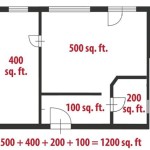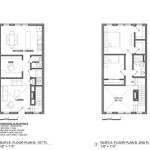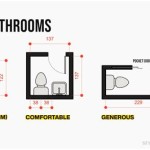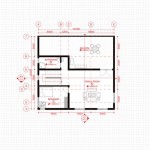Why Do Floor Plans Have Architectural Symbols On Them?
Floor plans, serving as fundamental documents in architecture, construction, and interior design, are visual representations of a building's layout from a bird's-eye view. These plans extend beyond simple depictions of rooms and walls. They are intricate diagrams densely populated with architectural symbols, each representing a specific building element, material, or component. The consistent use of these symbols is not arbitrary. It is crucial for clear communication and efficient execution throughout the building process.
The inclusion of architectural symbols in floor plans serves several critical purposes, facilitating seamless collaboration between architects, engineers, contractors, and other stakeholders. Without a standardized and universally understood system of symbols, ambiguity and misinterpretation could lead to costly errors, delays, and even structural failures. Architectural symbols offer a concise and visually efficient method to convey complex information, ensuring that everyone involved in the project is working from the same understanding.
Enhanced Clarity and Precision
One of the primary reasons for using architectural symbols is to enhance the clarity and precision of the floor plan. Instead of relying solely on textual descriptions, which can be lengthy and open to interpretation, symbols offer a direct and unambiguous representation of building elements. For example, a specific symbol is consistently used to denote a door, regardless of its size or material. This eliminates any potential confusion and ensures that the contractor understands exactly where the door is to be placed and what type of door is required.
Similarly, different symbols are assigned to various types of windows, indicating their size, style (e.g., casement, double-hung), and material (e.g., wood, aluminum). Walls are distinguished by line weight and fill patterns to indicate their construction type (e.g., load-bearing, non-load-bearing, concrete, stud wall). Plumbing fixtures, electrical outlets, and HVAC components each have their own designated symbols. This level of detail allows the floor plan to communicate a wealth of information in a compact and easily digestible format.
Furthermore, architectural symbols promote a consistent language across different projects and firms. Standardized symbols, often dictated by building codes and professional organizations, reduce the learning curve for new team members and minimize the risk of errors arising from unfamiliar notations. The use of recognized symbols enhances the professional credibility of the floor plan and demonstrates adherence to industry best practices.
The precision afforded by architectural symbols extends to dimensional accuracy. While the floor plan itself is drawn to scale, symbols provide specific reference points for measurements. For instance, a symbol indicating a sanitary fixture allows precise placement of the water supply and drain lines. The layout of electrical symbols highlights the exact location of wiring to ensure compliance with relevant codes and regulations.
Digital tools and Computer-Aided Design (CAD) software have further refined the use of architectural symbols. CAD libraries offer pre-drawn symbols that can be easily inserted into floor plans, ensuring consistency and accuracy. These digital symbols often include embedded data, such as manufacturer specifications and material properties, further enriching the information conveyed by the floor plan. The availability of digital symbols also simplifies the process of making revisions and updates to the floor plan, streamlining the design process.
Facilitating Efficient Communication
Effective communication is paramount in any construction project, and architectural symbols play a vital role in facilitating this communication. Floor plans equipped with standardized symbols serve as a common language for all stakeholders, regardless of their background or expertise. This unified understanding reduces the potential for miscommunication and ensures that everyone is on the same page throughout the project lifecycle.
Consider a scenario where an electrician is tasked with wiring a building based solely on a textual description of the electrical layout. The description might be complex, prone to ambiguity, and difficult to visualize. However, when presented with a floor plan containing electrical symbols, the electrician can quickly identify the location of outlets, switches, lighting fixtures, and other electrical components. The symbols provide a clear and visual representation of the electrical system, enabling the electrician to efficiently plan and execute the wiring work.
Similarly, plumbers rely on symbols to identify the location of water supply lines, drain lines, and plumbing fixtures. HVAC technicians use symbols to understand the layout of ductwork, air handlers, and thermostats. By using standardized symbols, these different trades can coordinate their work effectively and avoid conflicts or clashes. The floor plan acts as a central reference point, guiding the execution of each trade and ensuring that their work integrates seamlessly with the overall building design.
Architectural symbols are also essential for communicating design intent to clients. While clients may not have the technical expertise to interpret complex architectural drawings, symbols can help them understand the layout and functionality of the building. For example, a symbol representing a kitchen island allows clients to visualize the placement and size of the island within the kitchen space. This visual representation can facilitate discussions and feedback, ensuring that the final design meets the client's needs and expectations.
Furthermore, building permits often require floor plans that adhere to specific standards and conventions. The use of recognized architectural symbols demonstrates compliance with these standards and facilitates the review process by building officials. Inaccurate or ambiguous symbols can lead to delays in permit approval and potentially require costly revisions. Utilizing standardized symbols ensures that the floor plan is readily understood by regulatory bodies and that the project can proceed without unnecessary delays.
Ensuring Accuracy and Preventing Errors
The use of architectural symbols is crucial for ensuring accuracy and preventing errors during the design and construction phases. Each symbol represents a specific element with defined characteristics, minimizing the risk of misinterpretation and discrepancies. Accurate floor plans developed using standardized symbols reduce the likelihood of mistakes occurring during the building process.
Without symbols, descriptions might be overly verbose or open to varying interpretations. This can lead to situations where contractors install elements in the wrong location, use incorrect materials, or fail to meet required specifications. Such errors can result in costly rework, project delays, and even structural problems that compromise the building's safety and integrity. Architectural symbols provide a safeguard against these potential problems by creating a single, clear, and visual reference point for everyone involved.
By employing a standardized system of symbols, architects and designers can create consistent and reliable floor plans. Errors on architectural drawings can be extremely expensive to correct after construction begins. Therefore, the initial drawings need to be as accurate as possible. This accuracy stems from using symbols rather than ambiguous text descriptions.
The benefits of using architectural symbols also extend to the building's long-term maintenance and operation. As-built drawings, which document the final configuration of the building, are essential for facility management and future renovations. These drawings rely heavily on architectural symbols to accurately represent the location of building elements, utilities, and systems. When repairs are needed, having clear and accurate as-built drawings with recognizable symbols helps maintenance personnel quickly locate and address the issue, reducing downtime and minimizing disruption to building occupants.
In summary, the inclusion of architectural symbols on floor plans is far from arbitrary. It is a fundamental aspect of the architectural design and construction process. Symbols promote clarity, facilitate communication, and ensure accuracy. They contribute to a more efficient, cost-effective, and reliable building process. Ultimately, the consistent and standardized use of architectural symbols is essential for the successful completion of any building project.

15 Key Floor Plan Symbols 74 Architectural Abbreviations Foyr

15 Key Floor Plan Symbols 74 Architectural Abbreviations Foyr

Architectural Graphics 101 Symbols Life Of An Architect

15 Key Floor Plan Symbols 74 Architectural Abbreviations Foyr
:format(webp)?strip=all)
How To Read Floor Plan Symbols

Architectural Symbols A Guide To Drawing Blueprint Codes

Blueprint Symbols Free Glossary Floor Plan

Need To Know Floor Plan Symbols Evertise

15 Key Floor Plan Symbols 74 Architectural Abbreviations Foyr
:format(webp)?strip=all)
How To Read Floor Plan Symbols
Related Posts








